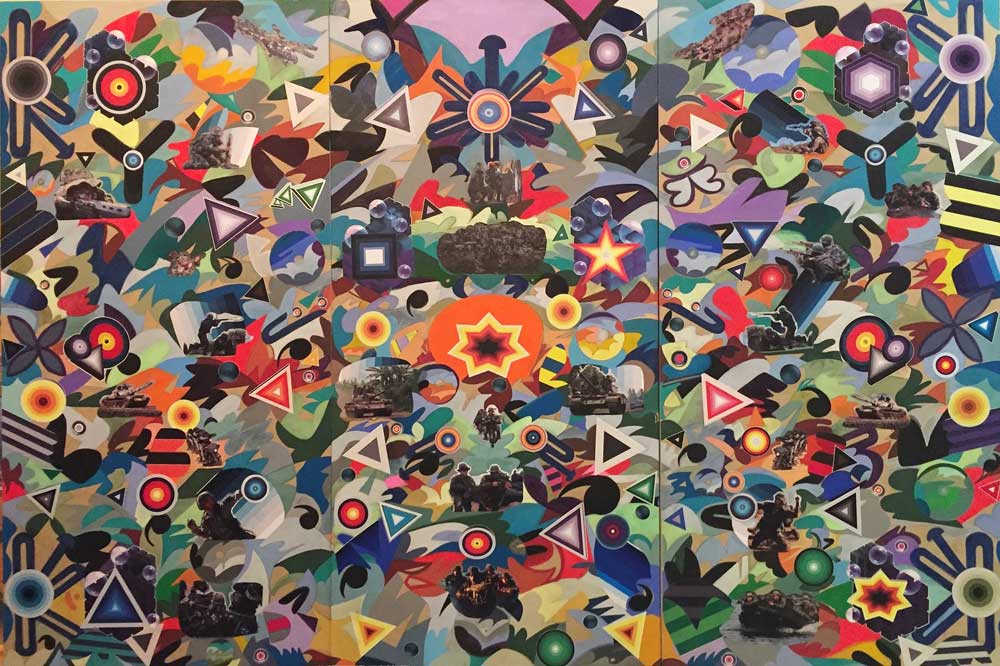« Reviews
David Gaither: Axiom
511 Gallery - New York
By Kim Power
Maximalism. A term often associated with overabundance and sensory saturation. David Gaither, collagist, painter and self-proclaimed maximalist, takes ownership of the term in his exhibit, “Axiom,” at 511 Gallery in Manhattan. Gaither’s enthusiasm and consistent work ethic have already landed him a solo show at the Tubman Museum in Macon, Ga., (”David Gaither: Growth & Expansion,“ 2016) and inclusion in group show at the Museum of the National Center of Afro-American Artists in Boston (”A Play of Abstraction at Northeastern Crossing,” 2015). Gaither has plans to exhibit his paintings at the Albany Museum of Art in Georgia, in 2017 and Detroit’s Charles H. Wright Museum of African American History in 2018.
Defining maximalism as “an ultra-saturation of complex colors with complex shapes” (Cascade Patch video interview with Marc Richardson, 2013), Gaither applies a flexible methodology in the realization of his vision, adjusting it according to the theme of each painting. Generally, the initial step of creating a rough sketch of the design, which Gaither describes as “mapping it out,” is followed by the application of a personal color-coding system to each section of the drawing, a bit like a sophisticated version of paint-by-numbers. The enlargement of this schematic is then realized in a variety of mediums, including acrylic, gouache and composite paint on canvas or MDF board.

David Gaither, The Chromatic Wars: Guerrilla Warfare / Maximal Insurgency, 2015, mixed media, acrylic, gouache, composite, and solidified paints, plus advanced polymers on panel (triptych), 49” x 75.” Courtesy of 511 Gallery and David Gaither.
Introducing the element of collage, Gaither’s triptych The Chromatic Wars, Guerrilla Warfare/Maximal Insurgency (2015) displays a panoply of interconnected shapes and forms that serve as a colorful camouflage for images of war (tanks, and soldiers with ammunition preparing to shoot, charge and throw grenades), downloaded and printed from the Internet. Gaither has used these symbols not to make a statement about actual warfare but to represent an explosive color war. The contextual dissonance is disturbing when you consider the absence of any reference to the true significance of the original imagery, which is reduced to being one more decorative element among many. The lack of consideration of what is signified undermines the subject matter’s authenticity which, as Walter Benjamin defines in his famous essay The Work of Art in the Age of Mechanical Reproduction (1935), “is the essence of all that is transmissible from its beginning, ranging from its substantive duration to its testimony to the history which it has experienced.”
The bold colors and shapes in Gaither’s works are a virtual minefield of visual information. When your ears stop ringing and your eyes adjust, you begin to see a sort of logic in the cacophony. There is a method in his madness. In all but one of Gaither’s paintings in Axiom, you will find a star, either five or seven pointed, expanding in layers of orange and yellow. At times it is central to the composition, as in Guerrilla Warfare or his tondo painting Starting to Grow - The Need for Expansion (2016), while in others, such as his other large triptych, The Maximal Composition #2 / Maximal Origami (2015), it is multiplied and becomes just one more element in the mix. It’s almost as if Gaither is using this icon as a representation of himself within a sea of visual stimuli.
Other modular forms (both painted on, collaged and applied in variable combinations of both) become evident as well, including circles, squares and rectangles that radiate rainbow bands of color. Windmill-like gears and typographic symbols such as commas suggest movement and use of the symbols as text. The manipulation of scale and shape through digital processes allows Gaither to design a complex web of imagery that has an endless variety of possible combinations. The result is a playful piece of eye candy with bright, primary colors intermixed with pastels and neutral grays in a carefully orchestrated design of hard-edge abstraction that implies a sense of kaleidoscopic depth within a flat picture plane. Gaither’s strong use of optical design techniques, such as ambiguous figures, ground relationships, and pulsating rays of color create a sense of motion within this space, ever expanding and receding. Resurrecting the qualities of Pop art appropriation and Bauhaus design through a maximalist tapestry of signs and symbols, Gaither’s paintings describe a multifarious universe of personal iconography.
(October 20 - December 5, 2016)
Kim Power is an international artist and writer currently residing in The Bronx. She holds a B.S. in Art Education from James Madison University and a Master in Fine Arts in painting from the New York Academy of Art. Her reviews have been published through The Brooklyn Rail, Arte Fuse, and Quantum Art Review.
Filed Under: Reviews



































Leave a Reply
You must be logged in to post a comment.